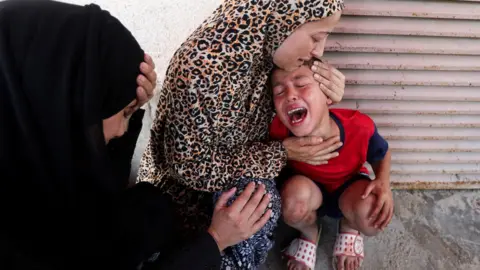In a tragic incident on July 10, 2025, at least 15 Palestinians, including eight children and two women, lost their lives as a result of an Israeli military strike in central Gaza. The attack occurred near a medical point in the town of Deir al-Balah, where individuals were queuing for nutritional supplements. According to reports from the Al-Aqsa Martyrs hospital, graphic footage has emerged showing the aftermath, with the bodies of children and others lying on the ground as medics rushed to tend to them.
The Israeli military claimed that the strike targeted a “Hamas terrorist” in the vicinity. They expressed regret for any collateral damage to civilians and indicated that the incident was currently under review. On the same day, other strikes in different areas of Gaza reportedly resulted in an additional 26 fatalities, amidst ongoing negotiations between Israeli and Hamas delegations aimed at establishing a new ceasefire and hostages’ release deal in Doha.
As mediators from the United States, Qatar, and Egypt sought to facilitate discussions, optimism about a potential breakthrough seemed to falter as substantial differences between the two parties persisted. The US, acting as a mediator, had reiterated its hopes for progress in the negotiations, but as of now, no significant advancements have been made.
The al-Aqsa hospital’s morgue became a scene of devastation, with grieving families mourning their losses. One woman recounted the agony of losing her pregnant niece, Manal, and her daughter, Fatima, in the attack, while her grandson remained in the intensive care unit. Witnesses at the scene expressed their despair and outrage, questioning the senselessness of the violence inflicted upon innocent lives. Emphasizing the tragic irony, one grieving individual lamented how the world was watching Gaza’s suffering without imparting effective help or intervention.
In defense of their actions, the Israel Defense Forces (IDF) stated that they had targeted a member of the elite Nukhba forces of Hamas’s military wing, allegedly involved in the deadly Hamas-led assault on Israel on October 7, 2023. The IDF acknowledged reports regarding civilian injuries and reiterated that the situation was under investigation, stressing their regret for any harm inflicted on uninvolved individuals.
This attack transpired during a fragile phase of diplomacy in Doha, where discussions around potential ceasefire agreements were ongoing. Noteworthy gaps remained between Israel and Hamas, with Israeli officials indicating that a consensus could take one or two weeks to achieve. Amidst the delicate negotiations, Israeli Prime Minister Benjamin Netanyahu suggested that a temporary ceasefire, if agreed upon, could be utilized by Israel to compel Hamas to disarm permanently. Should negotiations fail, Israel would be prepared to continue its military operations against Hamas.
Hamas, in response, portrayed the negotiations as arduous and attributed the ongoing stalemate to Israeli obstinacy. The organization reiterated its willingness to offer concessions, including the release of hostages, yet insisted on securing a comprehensive agreement that would halt the Israeli offensive.
Since the outbreak of this recent conflict, the toll of devastation on Gaza has been staggering. Reports indicate that since the onset of Israeli military campaigns following the October 7 attack, at least 57,680 individuals have lost their lives. The ongoing violence has led to widespread displacement, affecting much of the population. Over 90% of residences in Gaza are believed to be damaged or destroyed, severely crippling essential services such as healthcare, sanitation, and access to food, while shortages of fuel and medicine exacerbate the crisis further.
This latest escalation underlines the tragic consequences of ongoing hostilities, reverberating throughout the affected communities and raising urgent questions about humanitarian conditions and the pursuit of lasting peace in the region.











